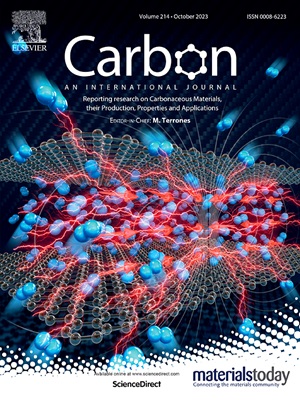A facile and rapid fabrication strategy of 3D-printed monolithic carbonaceous adsorbents for adsorptive desulfurization of fuel
IF 10.5
2区 材料科学
Q1 CHEMISTRY, PHYSICAL
引用次数: 0
Abstract
Realizing facile and rapid fabrication of active monolithic adsorbents possesses vital significance for promoting practical applications. In this work, three-dimensional resin carbonized carbon supported by silica was designed to construct monolithic carbonaceous 3D-RCC@SiO2 adsorbents through the strategy of "liquid crystal display (LCD) printing-low temperature carbonization", which possessing advantages of rapid prototyping, convenient processing, and relatively low-cost. LCD photopolymerization was adopted to achieve rapid prototyping of photosensitive resin with adding silicon oxide. Besides, the effects of carbonization treatment on physical and chemical properties, mechanical stability, and thermal stability of carbonaceous monoliths were further investigated in the temperature range of 250–450 °C. Among them, photosensitive resin served as the carbon source, and carbonized carbon can realize dual functions of maintaining integral structure and serving as active components. Furthermore, the single filler of monolithic carbonaceous adsorbent can achieve a fixed-bed adsorption desulfurization efficiency of 72.2 % and realize five cycles for fuel oil with low sulfur content at room temperature. In addition, the influence of the internal cubic hollow structure constructed by LCD printing on adsorption and mass transfer was further investigated, which can contribute to the advancement of practical desulfurization applications.
一种用于燃料吸附脱硫的3d打印单片碳质吸附剂的简易快速制造策略
实现高效快速制备活性单片吸附剂对促进实际应用具有重要意义。本研究通过“LCD打印-低温碳化”的策略,设计了二氧化硅支撑的三维树脂碳化碳,构建了单片碳质3D-RCC@SiO2吸附剂,具有成型快速、加工方便、成本相对较低的优点。采用LCD光聚合法,通过添加氧化硅实现了光敏树脂的快速成型。此外,在250 ~ 450℃的温度范围内,进一步研究了炭化处理对碳质单体材料理化性能、机械稳定性和热稳定性的影响。其中,光敏树脂作为碳源,碳化碳可以实现维持整体结构和作为活性组分的双重功能。单填料整体碳质吸附剂的固定床吸附脱硫效率可达72.2%,对低硫含量燃料油在室温下可实现5次循环。此外,还进一步研究了液晶打印构建的内部立方空心结构对吸附传质的影响,为实际脱硫应用的推进做出贡献。
本文章由计算机程序翻译,如有差异,请以英文原文为准。
求助全文
约1分钟内获得全文
求助全文
来源期刊

Carbon
工程技术-材料科学:综合
CiteScore
20.80
自引率
7.30%
发文量
0
审稿时长
23 days
期刊介绍:
The journal Carbon is an international multidisciplinary forum for communicating scientific advances in the field of carbon materials. It reports new findings related to the formation, structure, properties, behaviors, and technological applications of carbons. Carbons are a broad class of ordered or disordered solid phases composed primarily of elemental carbon, including but not limited to carbon black, carbon fibers and filaments, carbon nanotubes, diamond and diamond-like carbon, fullerenes, glassy carbon, graphite, graphene, graphene-oxide, porous carbons, pyrolytic carbon, and other sp2 and non-sp2 hybridized carbon systems. Carbon is the companion title to the open access journal Carbon Trends. Relevant application areas for carbon materials include biology and medicine, catalysis, electronic, optoelectronic, spintronic, high-frequency, and photonic devices, energy storage and conversion systems, environmental applications and water treatment, smart materials and systems, and structural and thermal applications.
 求助内容:
求助内容: 应助结果提醒方式:
应助结果提醒方式:


